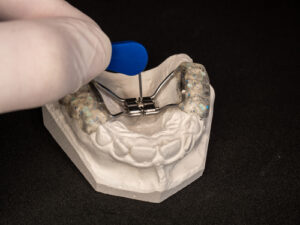 Everyone has heard stories about the palatal expander, if not from the patient themselves then their parents. While expanders can be uncomfortable, their time in a person’s mouth is short-lived, and the work that’s done helps make room for adult teeth. It helps to know what you’re getting into before your child receives this device so you can prepare for what interceptive orthodontics will really be like.
Everyone has heard stories about the palatal expander, if not from the patient themselves then their parents. While expanders can be uncomfortable, their time in a person’s mouth is short-lived, and the work that’s done helps make room for adult teeth. It helps to know what you’re getting into before your child receives this device so you can prepare for what interceptive orthodontics will really be like.
1. There Will Some Lisping and Slobbering
The presence of the expander takes some getting used to for your child and it may cause them to speak with a bit of a lisp, at least on certain words. The expander also contributes to excess saliva production. These side effects are usually temporary and, even if they’re not, your child will get used to them after about a week as the expander blends into their daily life.
2. Parents Have a Job to Do
The palatal expander requires assistance on a parent’s part. The expander must be turned daily so the device opens the palate to widen a narrow upper jaw. This requires the use of a “key” which is fitted into the expander twice a day and turned toward the back of the mouth until the required movement is achieved. You might be nervous when you first approach your child with this instrument but if you take your time and follow the orthodontist’s instructions, it will get easier every time.
3. Food Is Going to Get Stuck
There is a miniscule space between the top of the expander and the roof of your child’s mouth. No matter what your child eats, food is going to get stuck there. After that first week, your child will adjust and the annoyance of the expander will lessen. It helps to have a water pik to do the job of pushing out leftover food particles. Your kid will love using the device and it will do a great job of rinsing their expander and cleaning between their teeth.
4. A Gap Is Good
Most palatal expanders are only actively worn for a few weeks before the work of turning the appliance is done. During these early days, every turn of the key will pull the palate a little further apart, making room for adult teeth to erupt in their proper positions. This action will also leave a small gap between your child’s front teeth. This is normal and expected and a great sign that you’re turning the key properly in the orthodontic appliance.
5. You Must Put in the Time
Every patient is different and some may need several weeks to reach the desired results. No matter how long it takes for the expander to move the palate, it will be left in place for about six months afterward to prevent relapse and allow for healing time. In many patients, partial braces are placed on their front teeth to begin early alignment.
Expanders are a common orthodontic appliance. If your child has crowded teeth, teeth that aren’t erupting, or baby teeth that aren’t being lost, schedule a consultation with Dr. Soleil in Woodinville, WA, to find out if they’re a good candidate for a palatal expander.

